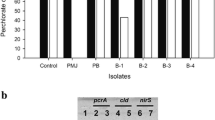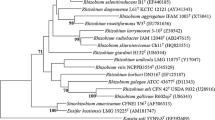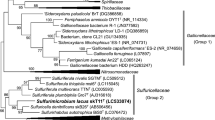Abstract
A bacterium that reduces the soluble selenium oxyanions, selenate and selenite, to insoluble elemental red selenium (Se0) was isolated from a laboratory reactor developed to remove selenate from groundwater. Gene sequence alignment of the 16S rRNA allowed identification of the isolate as Azospira oryzae. Biochemical and morphologic characterization confirm the identification. The isolate reduces selenate and selenite to Se0 under microaerophilic and denitrifying conditions but not under aerobic conditions. It does not use selenate or selenite as terminal e¯ donors. Se oxyanion reduction causes the formation of Se nanospheres that are 0.25 ± 0.04 μm in diameter. Nanospheres may be associated with the cells or free in the medium. The enzymatic activity associated with the reduction of selenate has a molecular mass of approximately 500 kD, and the enzymatic activity associated with the reduction of selenite has a mass of approximately 55 kD. Selenite reduction was inhibited by tungsten. The molecular masses of these activities were different from those associated with the reduction of dimethylsulfoxide, sulfate, and nitrite. This bacterium, or perhaps its enzymes or DNA, might be useful for the remediation of waters contaminated with Se oxyanions.




Similar content being viewed by others
Literature Cited
Achenbach LA, Michaelidou U, Bruce RA, Fryman J, Coates JD (2001) Dechloromonas agitata gen. nov., sp. nov. and Dechlorosoma suillum gen. nov., sp. nov., two novel environmentally dominant (per)chlorate-decreasing bacteria and their phylogenetic position. Int J Syst Evol Microbiol 51:527–533
Afkar E, Lisak J, Saltikov C, Basu P, Oremland RS, Stolz JF (2003) The respiratory arsenate reductase from Bacillus selenitireducens strain MLS10. FEMS Microbiol Lett 226:107–112
Bruce RA, Achenbach LA, Coates JD (1999) Decrease of (per)chlorate by a novel organism isolated from paper mill waste. Environ Microbiol 1:319–329
Buck JD (1982) Nonstaining (KOH) method for determination of Gram reactions of marine bacteria. Appl Environ Microbiol 44:992–993
Chiong M, Gonzales E, Barra R, Vasquez C (1988) Purification and biochemical of tellurite-reducing activities from Thermus thermophilus HB8. J Bact 170:3269–3273
Garbisu C, Ishii T, Leighton T, Buchanan BB (1996) Bacterial decrease of selenite to elemental selenium. Chem Geol 132:199–204
Ganther HE, Levander OA, Sauman CA (1966) Dietary control of selenium volatilization in the rat. J Nutr 88:55–60
Greenberg AE, Clesceri LS, Eaton AD (eds) (1992) Standard methods for the examination of water and wastewater, 18th edn. Washington, DC: American Public Health Association, American Water Works Association and Water Environmental Federation, pp 82–93
Hunter WJ, Kuykendall LD (2004) Determination of dimethylselenide and dimethyldiselenide by gas chromatography photoionization detection. J Chromatogr 1038:295–297
Hunter WJ (2006) Removing selenate from groundwater with a vegetable oil based biobarrier. Curr Microbiol 53:244–248
Hunter WJ, Kuykendall LD (2006) Identification and characterization of an Aeromonas salmonicida (syn Haemophilus piscium) strain that decreases selenite to elemental red selenium. Curr Microbiol 52:305–309
Karlson U, Frankenberger Jr WT (1988) Determination of gaseous selenium-75 evolved from soil. Soil Sci Soc Am J 52:678–681
Kumar S, Tamura K, Nei M (2004) MEGA3: Integrated software for molecular evolutionary genetics analysis and sequence alignment. Brief Bioinform 5:150–163
Lund K, DeMoss JA (1976) Association-dissociation behavior and subunits structure of heat-released nitrate reductase from Escherichia coli. J Biol Chem 251:2207–2213
McCready RGL, Campbell JN, Payne JI (1996) Selenite reduction by Salmonella heidelberg. Can J Microbiol 12:703–714
Reinhold-Hurek B, T Hurek (2000) Reassessment of the taxonomic structure of the diazotrophic genus Azoarcus sensu lato and description of three new genera and new species, Azovibrio restrictus gen. nov., sp. nov., Azospira oryzae gen. nov., sp. nov. and Azonexus fungiphilus gen. nov., sp. nov. Int J Syst Evol Microbiol 50:649–659
Schmitz RA, Albracht SPJ, Thauer RK (1992) Properties of the tungsten-substituted molybdenum formylmethanofuran dehydrogenase from Methanobacterium wolfei. FEBS Lett 309:78–81
Tan Z, Reinhold-Hurek B (2003) Dechlorosoma suillum Achenbach et al. 2001 is a later subjective synonym of Azospira oryzae Reinhold-Hurek and Hurek 2000. Int J Sys Evol Microbiol 53:1139–1142
Zieve R, Ansell P, Young T, Peterson P (1985) Selenium volatilization by Mortierella species. Trans Br Mycol Soc 84:177–179
Acknowledgments
The author thanks Robin Montenieri and Cathy Cannon for expert technical assistance. Manufacturer and product names are given for readers’ convenience and do not reflect endorsement by the United States government. This article was the work of United States government employees engaged in their official duties and is exempt from copyright.
Author information
Authors and Affiliations
Corresponding author
Rights and permissions
About this article
Cite this article
Hunter, W.J. An Azospira oryzae (syn Dechlorosoma suillum) Strain That Reduces Selenate and Selenite to Elemental Red Selenium. Curr Microbiol 54, 376–381 (2007). https://doi.org/10.1007/s00284-006-0474-y
Received:
Accepted:
Published:
Issue Date:
DOI: https://doi.org/10.1007/s00284-006-0474-y




